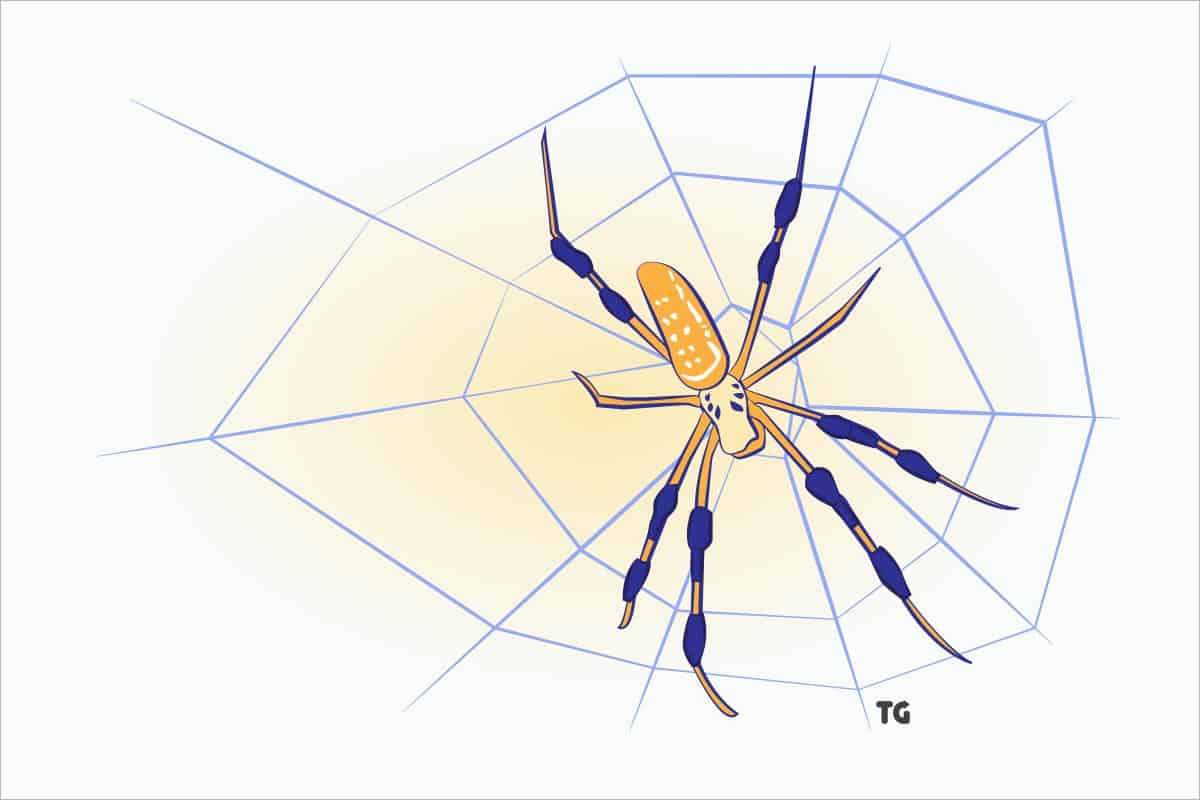Thailand is blessed with an abundance of wildlife and biodiversity. It is part of the Indo-Burma Hotspot – a tropical part of Asia renowned for being one of the most biologically rich on our planet.
Thailand may not be the biggest country, but it is home to an incredible array of living organisms and their ecosystems. Approximately 10% of the world’s animals live there. And with one-third (previously two-thirds) of its land being rainforest, as you would expect, Thailand is an excellent habitat for spiders. So, yes, these exotic, creepy crawlies are here. (Source)
It is estimated that there are 700 – 1,200 species of spider in Thailand. However, the likelihood is that the number in nature is much higher. This is because not all species have been collected and studied. The remaining are yet to be officially identified. Spiders also come in various sizes depending on the species.
Curious to learn more? Whether you are nervous or excited about the prospect of encountering spiders in Thailand – the good news is you’ve come to the right place.
This guide will cover the most common species of spider you could bump into, the risks involved if you do, and some safety advice.
But first, let’s get this out of the way:
Does Thailand Have Poisonous Spiders?
Some species of spiders possess venom, while others do not. And even though their venom is poisonous, it is designed to be deadly or paralyze their prey, such as insects or small animals. Their venom is not considered poisonous to humans. Severe symptoms, such as toxicity, injury, or death, are extremely rare unless the patient suffers a severe allergic reaction.
Whatsmore, if you avoid Thailand’s forest areas, the chances of encountering a dangerous spider are very low. They are also non-aggressive, so the possibility of being bitten by one is even lower.
The 9 Most Common Types of Spiders in Thailand
But if you do run into a spider during your trip, it will probably be one of these:
| # | Species | Official (Scientific Name) | Thai |
| 1 | Banana Spiders | Trichonephila clavipes | ผ้าไหมสีทองลูกโลก-ทอผ้า, แมงมุมผ้าไหมสีทอง, แมงมุมกล้วย |
| 2 | Jumping Spiders | Salticidae | แมงมุมกระโดด |
| 3 | Thailand Cave Spiders | Loxosceles rufescens | แมงมุมถ้ำ, แมงมุมสันโดษเมดิเตอร์เรเนียน |
| 4 | Furry Spiders | Lycosidae | แมงมุมหมาป่า |
| 5 | Thailand Black Tarantulas | Haplopelma minax or Cyriopagopus minax | แมงมุมทารันทูล่าสีดำ, ทารันทูล่าดำ, บึ้งดำ |
| 6 | Funnel Spiders | Allagelena monticola | แมงมุมใยกรวย, แมงมุมทอกรวย |
| 7 | Spindly Spiders | Pholcus phalangioides | แมงมุมคุณพ่อขายาว, แมงมุมห้องใต้ดิน, แมงโหย่ง |
| 8 | Huntsman Spiders | Heteropoda venatoria | แมงมุมพเนจร |
| 9 | Giant Orb Spiders | Nephila pilipes | แมงมุมใยทองท้องขนาน |
Does this look like a scary list? Time for some exposure therapy…
1. Banana Spider
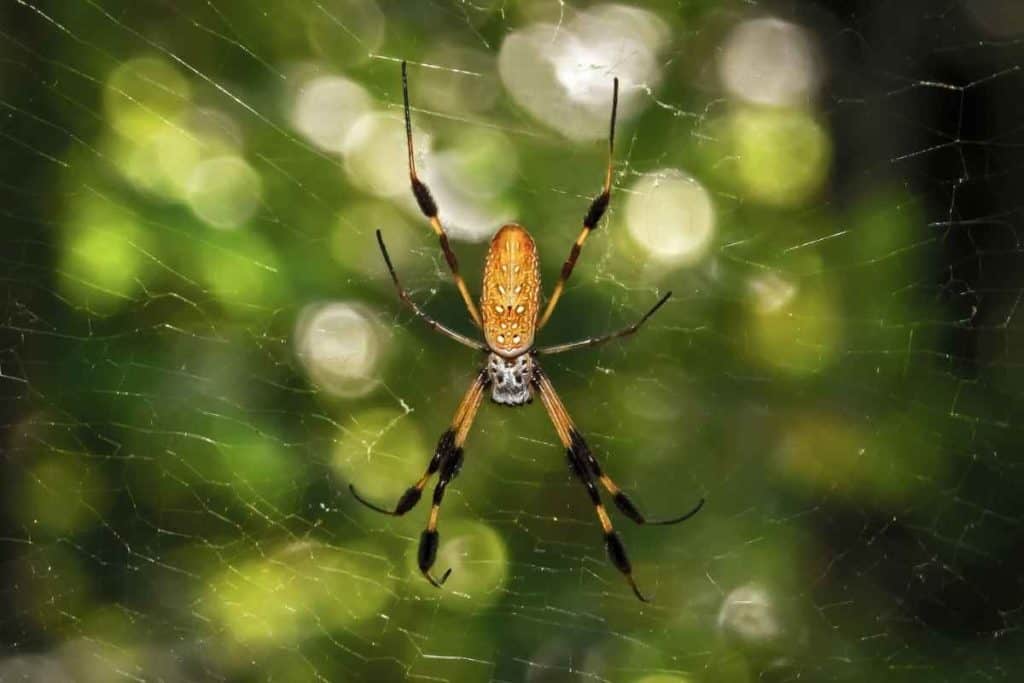
Banana Spiders are also known as “Golden-Silk Orb Weavers” or “Golden Silk Spiders” because of the golden color of their silk. The female spiders have a large size (around 55 mm) while males are smaller (6 mm) in body size. Both of them have distinctive red-brown and yellow colors. (Source)
Habitat:
The preferred climate of the golden-silk orb weaver is hot and humid. However, they are more commonly found in the forest – leisurely hanging in their web along walking trails or deeply secluded areas.
Diet:
Banana Spiders are good predators. They build large, asymmetrical circular webs (which may be up to 0.5 meters in diameter) attached to trees and low shrubs in woods to catch flying prey. They subdue any prey by injecting venom.
Their diet is mainly small-to-medium-sized insects, such as grasshoppers, bees, flies, moths, etc.
Risk:
Banana Spiders in Thailand have a reputation for inflicting painful bites. However, they are shy and not known to be aggressive towards humans. So, they rarely bite. If they do, it’s in self-defense.
These bites may cause mild pain and slight redness in the bite area. They generally cause no permanent harm, but there may be some symptoms. In most cases, their venom is not enough to harm a healthy adult human. However, in cases of severe reactions, it is recommended to seek immediate medical care.
2. Jumping Spiders
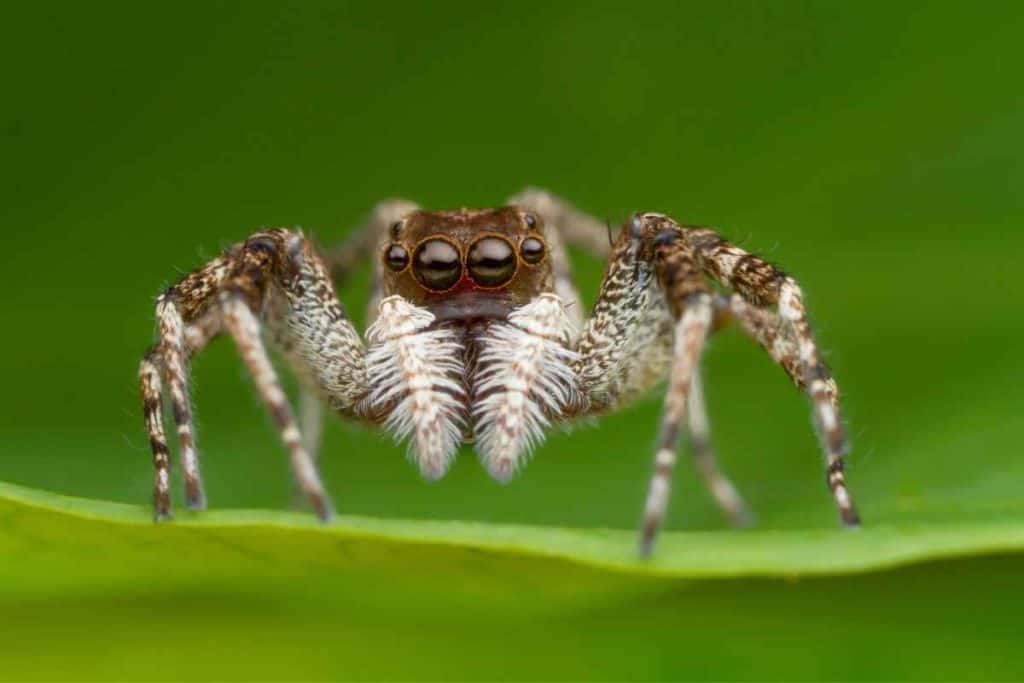
With over 6,000 separate species, Jumping Spiders are the largest family of spiders. They are pretty small (around 2-20 mm) in size. They can be identified by the four large eyes on their heads, equipping them with superior vision compared to other spiders.
This gives them an incredible ability for courtship, hunting, and navigation. These spiders move relatively slowly but can perform agile jumps when hunting and responding to sudden threats. (6, 7, 8, 9)
Habitat:
Jumping spiders can be found in a variety of habitats in Thailand. This includes tropical forests (where they are found the most), deserts, and brush lands. They are also present in mountainous regions – and are even seen on the slopes of Mount Everest.
Diet:
Jumping spiders are hunters, and their hunting behavior is often compared to that of cats. With incredible vision, they can stalk and attack any prey from a distance. When it is time to strike, they can jump up to 20 times their body length to capture their prey.
They typically eat ants, flies, and grasshoppers. Although they are predators, some species have been known to include nectar in their diets.
Risk:
Jumping Spiders of Thailand are poisonous but not considered a dangerous species to humans. They only bite humans in self-defense. They do possess fangs and produce venom, but the venom is generally not a medical concern.
Those who do get bitten may get a red or swollen area. In more severe cases, there can be some pain.
3. Cave Spiders
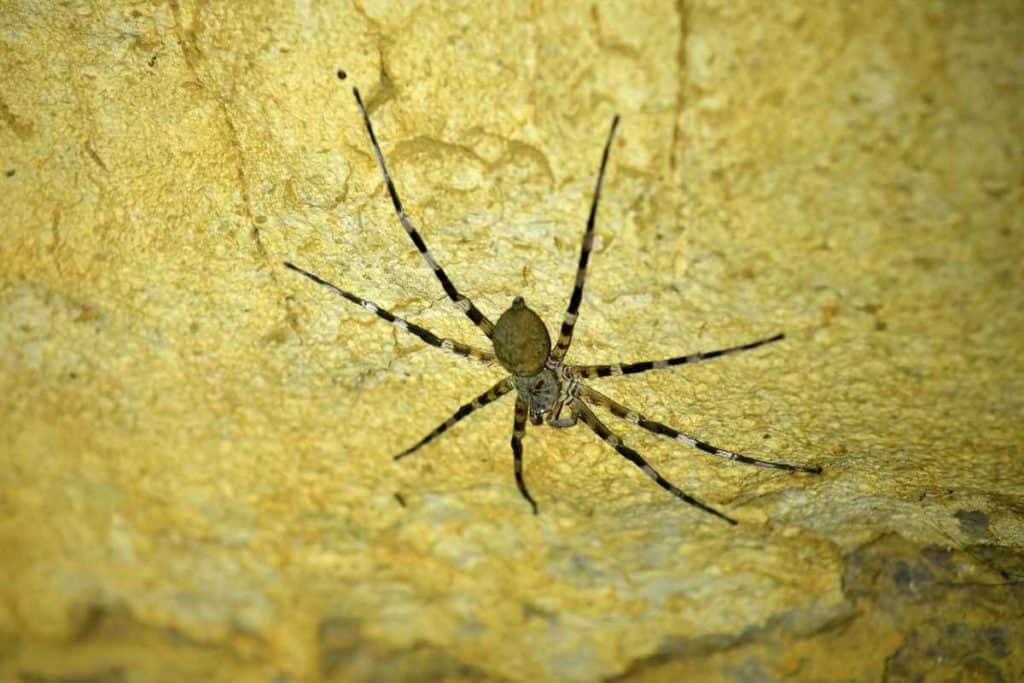
Thailand’s Cave Spiders (also known as Mediterranean Recluse Spider) belong to the Loxosceles genus.
This family contains many of the most dangerous spiders in Thailand and, indeed, the world. They originate from the Mediterranean region. But, nowadays, they can be found in many parts of the world.
It is believed that these cave spiders found their way to Thailand during World War II when ships transported construction materials from Japan.
They can be identified by their three pairs of two eyes organized in a triangle shape and a violin-shaped pattern on their cephalothorax (the portion of the body to which the legs attach).
Cave spiders are medium-size, with both males and females growing to approximately 7-7.5 mm in length. (Source)
Habitat:
Cave spiders are regarded as one of the most invasive species in the world. They can be found in damp areas. As their name indicates, they naturally live in caves. They can also be seen in buildings such as basements and tunnels.
Diet:
Cave spiders can feast on small insects, but their preferred meal is cockroaches and silverfish.
Risk:
Thailand Cave Spiders are poisonous but not harmful to humans. The bite of the cave spiders may cause “loxoscelism,” which causes skin necrosis (such as the death of body tissue).
This can cause severe damage; however, most cases are medically insignificant. Blistering and burning sensations may appear after being bitten for 2-8 hours.
4. Furry Spiders
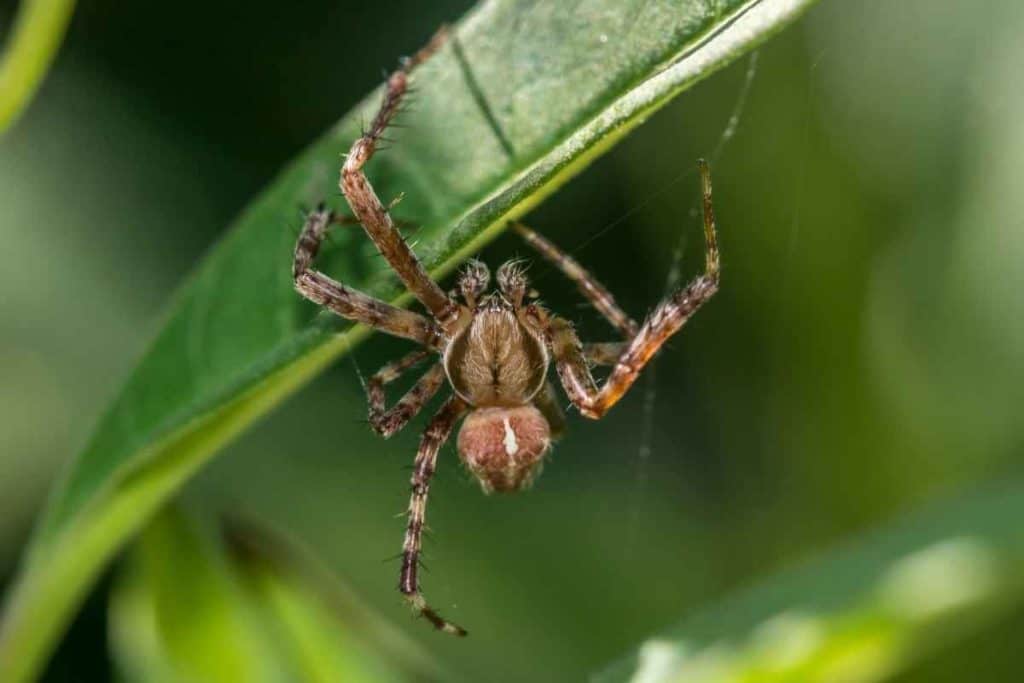
Furry spiders may include wolf spiders – one of the most common in Thailand. These spiders have eight eyes with excellent eyesight, making them fantastic hunters.
They are very small and furry, with a body ranging between 10 and 35 mm in size. They have distinctive zebra-like striped legs and a tawny and brown double-barrelled body. (Source)
Habitat:
Furry spiders (or wolf spiders) will not be found in webs, as they do not spin them. They live in solitude and without a permanent home. They wander around forests and gardens, mainly grassy and leafy woodland areas.
Some species may build burrows with a trap door. During winter, they may seek shelter and move into houses and buildings in Thailand’s rural areas.
Diet:
These spiders eat insects and other invertebrates. Being brave and powerful, the large females may consume small vertebrates, such as amphibians and reptiles, if they encounter them.
Risk:
Furry spiders in Thailand are not poisonous and not aggressive. They do not threaten people, but their bites may be painful and include swelling and itchiness, or worse, if you suffer an allergic reaction.
However, some species found in Australia have previously been linked to death in humans. Fortunately, there have been no such cases reported in Thailand.
5. Bird Spiders
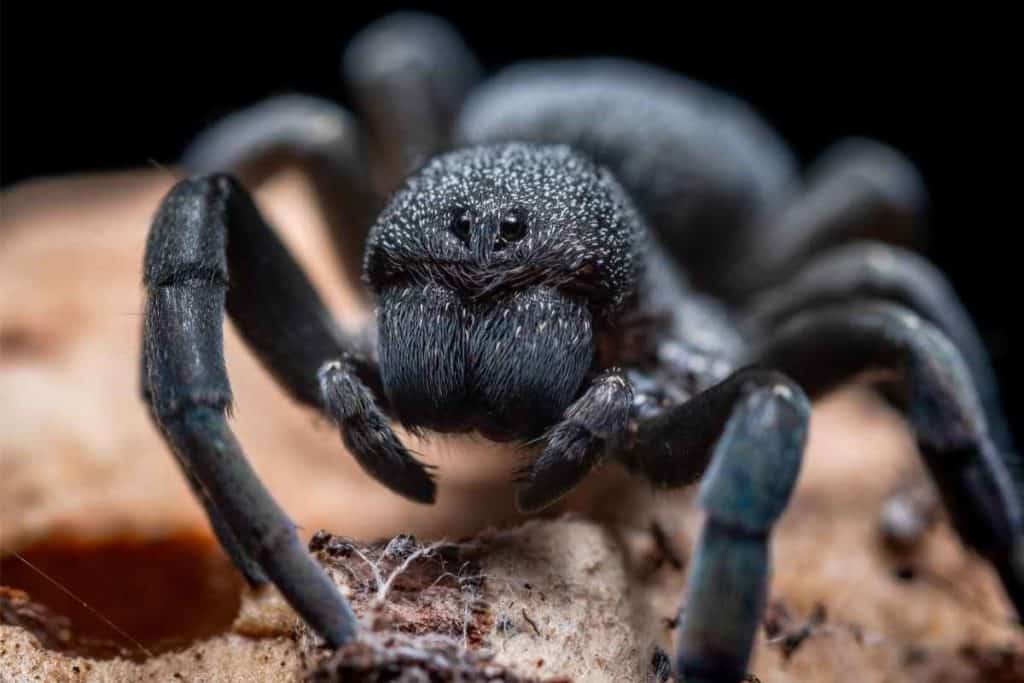
Bird spiders are a nickname for the famous “Thailand Black Tarantula.” These species are unique tarantulas with dark-colored, fuzzy bodies.
They are one of the larger spiders in Thailand, measuring up to 15 cm and weighing up to 42 grams. The male spiders are smaller and have a shorter lifespan than the female.
As an ‘old world’ tarantula, they tend to be more temperamental and faster-moving compared to more docile and slower ‘new world’ tarantulas. Therefore, the Thailand Black Tarantula has the propensity to bite in self-defense if they feel under threat. (Source)
▸ Check out our complete Thailand Black Tarantula Guide to learn more about their temperament and the difference between the old world and new world tarantulas.
Habitat:
Bird spiders are common in tropical forests throughout Southeast Asia. Like all tarantulas, they are fond of high humidity situations. They live underground by building a deep burrow in soil or tree bark and only leave their home to eat. Many of them can be found in Khao Sok National Park, Thailand. (View Map)
Diet:
Thailand Black Tarantulas are opportunistic carnivores, often consuming birds, lizards, frogs, and insects.
Risk:
Bird spiders in Thailand are not very aggressive. They are actually quite nervous — however, their high willingness to be defensive means. So, there is a risk that they will bite and cause harm.
Although Thailand Black Tarantulas possess venom that can be pretty painful – their bites are not deadly unless the victim has an allergic reaction. You’ll find more safety advice in our complete guide.
6. Funnel Spiders
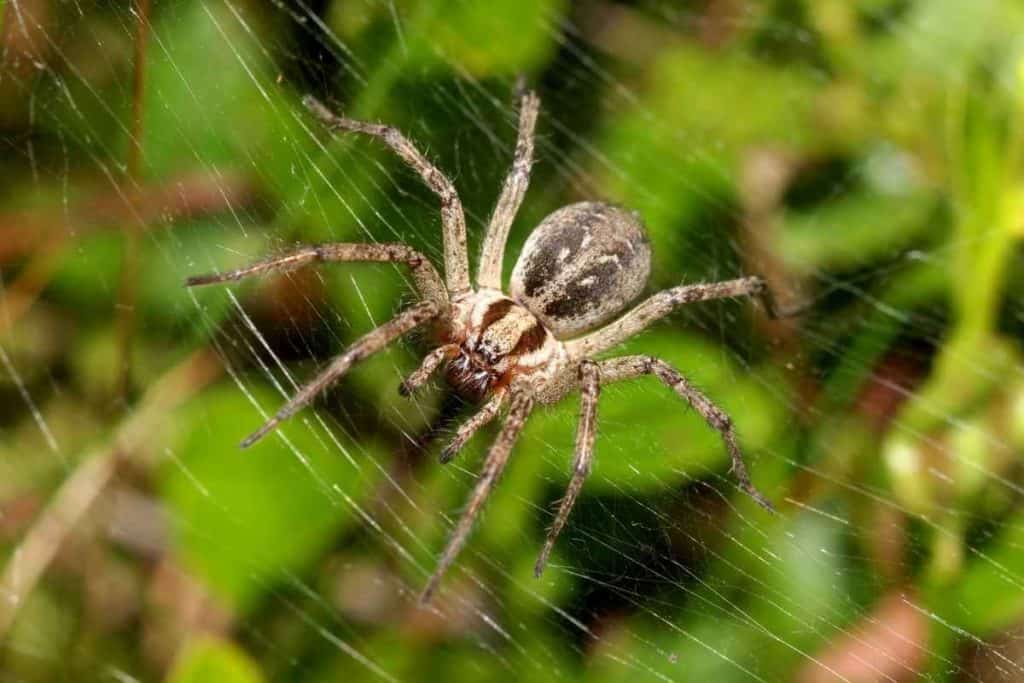
Thailand’s Funnel Spiders are a new species of ‘funnel-web spider’ or ‘funnel weaver spider’ from northern Thailand. They resemble the widely distributed species Allagelena opulenta from China, Korea, and Japan.
Their name is about their funnel-shaped webs. They are of medium size. The smallest spider in the Agelenidae family is about 4 mm, while the largest species can grow up to 20 mm. Their bodies are yellow and clothed with short black hair. (Source)
Habitat:
Most funnel spiders are rarely seen because they live in underground burrows or stumps, tree trunks, and plants above the ground. Their burrows are surrounded by opaque silk, and their webs are built-in grass or shrubs.
In Thailand, they live in forests or woodlands with pine trees, such as the Doi Inthanon National Park, Chiang Mai Province, northern Thailand. (View on Map)
Diet:
Funnel spiders prefer to feed on insects and small vertebrates, including lizards and frogs.
Risk:
Thailand Funnel Spiders are a relatively new species, and their dangers are inconclusive. If they are similar to those found in China, their venom is one of the insecticidal toxins – agelenin.
However, some of these species can be considered in the bracket of the most venomous spiders in Thailand. This is because their venom is highly toxic, which may cause very severe symptoms that can worsen over time. (Source)
The bite from one of these spiders should be treated as potentially life-threatening – although only approximately 10-15% of bites are venomous.
7. Spindly Spiders
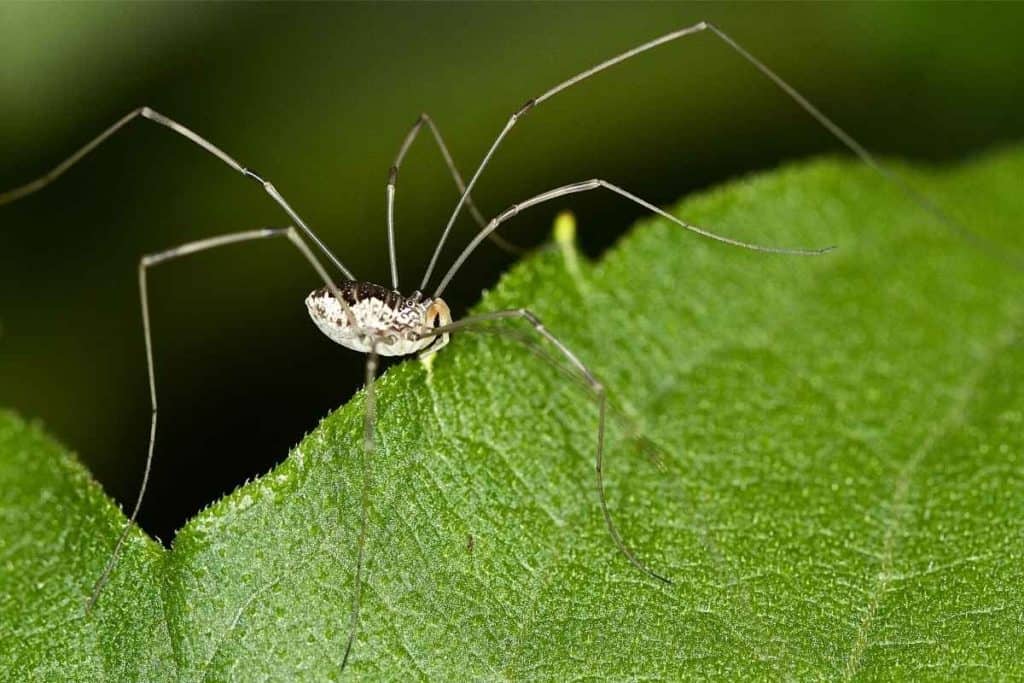
Thailand’s Spindly Spiders can also be known as “Harvestman Spiders,” “Daddy Longlegs,” “Cellar Spiders,” etc.
They are a family of spiders containing over 1,800 species around the world. They are known to be one of the Kingdom’s least threatening to humans. They have a small body shaped like a peanut with skinny and long legs, which is difficult to see from the naked eye.
Habitat:
These spiders are found on every continent in the world except Antarctica. They usually reside in dark and damp areas, such as caves. Or, you may spot one walking up a tree within any of Thailand’s forests. Harvestman Spider also constructs their webs in attics and cellars, which is how they got their name.
Diet:
Spindly Spiders have a diet similar to most other spiders. They feast on small insects, including moths, mosquitoes, caterpillars, larvae, and slugs. Plus, anything else that is small enough to consume.
Risk:
Spindly Spiders are not venomous as they do not have venom glands or fangs. They are not known to bite or threaten humans.
In fact, they cannot bite humans due to the size of their legs. Whatsmore, the tiny claw-like shapes on their face that are used for gripping bark and prey are too small to break human skin.
Interestingly, there is a popular myth that these spiders are the most venomous spider on earth. But no scientific research supports this, and there are no documented cases of this species biting a human.
So, if you are worried about deadly spiders in Thailand, this species is not the one to focus on.
8. Huntsman Spider
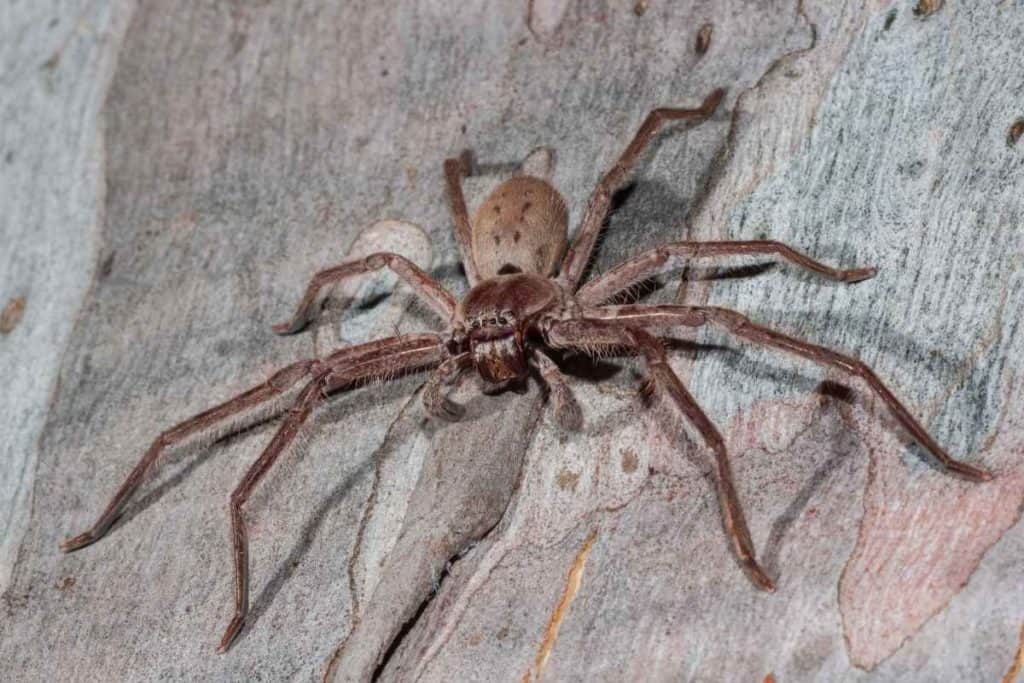
Huntsman Spiders are one of the biggest spiders in Thailand. They are 2 to 2.5 cm long and 7 to 10 cm wide. They have a leg span that can reach up to 2 cm, making them run very fast.
Like all types of spiders, females are usually larger than males. The most interesting thing is they can grow as large as 30 cm. They have a mottled brown and tan color with long, solid legs and a fuzzy body that helps them blend in with the forest’s ground.
Habitat:
Huntsman spiders do not spin a web. They would instead roam around and explore the wooden floor in forest areas. Sometimes they live in caves where their natural camouflage makes them invisible to prey.
However, they may sometimes wander into people’s homes or rural dwellings since they are considered curious spiders, as their name suggests.
Diet:
Huntsman Spiders feed on various insects. Since they do not spin webs, they hunt and inject them with venom. Besides insects, they are also known to feed on scorpions and bats. These spiders are considered helpful to have in homes. By feeding on common bugs, they can provide efficient pest control.
Risk:
Huntsman spiders are quite scared of humans. However, they may occasionally chase people. But this behavior indicates they are afraid and confused, as they dislike biting.
They only bite in self-defense if handled roughly. If you do get bitten, it can be painful. They are indeed venomous, but it is not considered dangerous.
A bite from a huntsman will often only produce moderate symptoms, such as nausea and headache. Their toxin is similar to a bee-sting which will subside in a few days.
9. Giant Orb Spiders Thailand
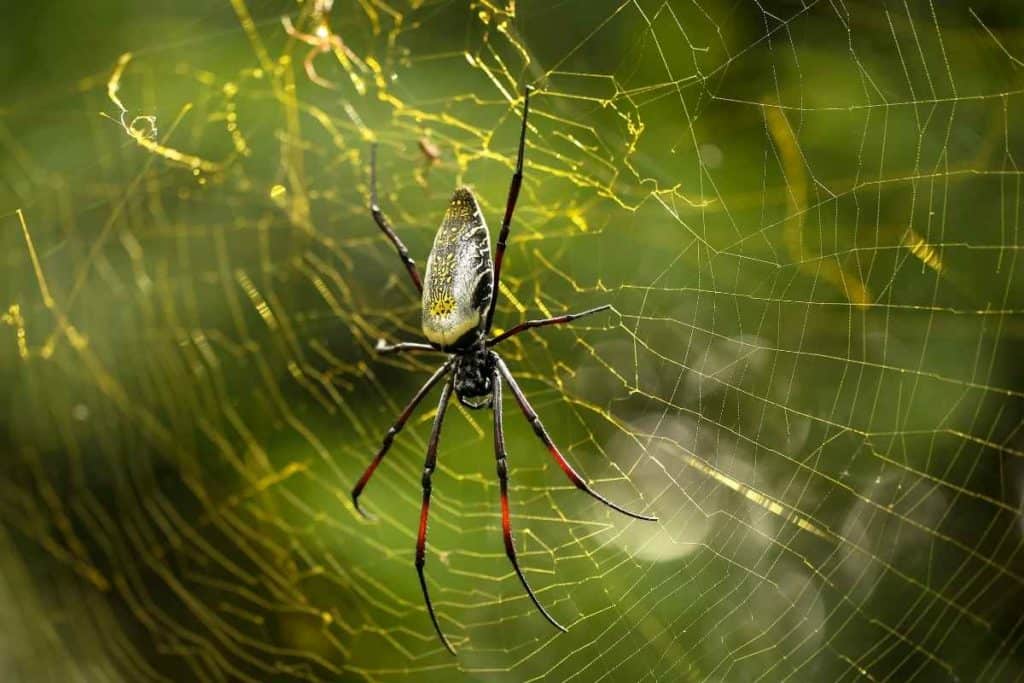
Giant Orb Spiders Thailand, also known as “Golden Orb-Weaver Spider,” obtained its name from the color of its golden-yellow web.
These spiders are dark greyish-brown with white hair on their heads and chests, with black with yellow spots on their backs. Female spiders are large and grow to 30–50 mm, while males grow to 5–6 mm.
Habitat
Giant Orb Spiders reside all over countries in East and Southeast Asia. They are often found in forests and gardens of tropical climates while preferring not to be in direct sunlight.
Diet
These spiders are carnivorous. They feast on insects they can overpower (such as grasshoppers, bees, flies, etc.). Sometimes they prey on insects with a size range from 2 mm to even insects larger size than themselves.
Interestingly, they can adjust the ultraviolet radiation reflected by stripes on their body to attract prey. This makes them look like food sources for insects rather than predators. They are active during daylight hours.
Poison
Although Thailand’s Giant Orb Spiders contain venom, they are not poisonous to humans. As with many other spiders, the bite is comparable to just a bee sting, so it is not considered harmful.
Eating Spiders in Thailand
Now you’ve been given the lowdown on Thailand’s spiders – has it allayed any fears?
Now, you’ve probably heard about tourists treating themselves to “an unusual meal” in Thailand. That is, eating insects.
Well, it’s true. Insects are considered an alternative protein source by Thai people, especially those living in rural areas. There are about 200 species of edible insects in Thailand, with around 20 of these usually eaten. The most popular are silkworm pupae, bamboo worms, beetles, locusts, grasshoppers, and crickets.
Interestingly, eating these deep-fried insects has become a cultural phenomenon among tourists.
When you visit any night market in Thailand, you’ll see them for sale on street stalls. If this sounds tasty to you, check out the famous Khao San Road or Chinatown in Bangkok, Bangla Road in Phuket, Chiang Mai Walking Street, or Pattaya Walking Street, and treat yourself to this unique bar snack. (They go well with a Thai beer.)
But do they eat spiders in Thailand?
Spiders are not generally eaten in Thailand. You may see some unlovable insects sold as food at the markets, such as cockroaches, scorpions, and spiders. But it does not mean that most Thai people eat these exotic insects as common food. Fried scorpions and spiders typically cater to daring and adventurous tourists.
Moreover, although it is believed that Thai people have eaten these types of insects in the past, there is no indication that the locals still eat them nowadays.
Will I See Spiders (or Snakes) in My Hotel?
The likelihood of finding a spider or snake in your Thailand hotel room is extremely low. Although Thailand is a tropical country home to a wide variety of spiders and snakes – encountering them is very rare. Especially in major cities and urban areas. However, the chances of seeing a snake are higher than seeing a spider.
This is because coming into contact with a snake is more likely to occur during Thailand’s rainy season. Heavy rain and flooding force snake’s to move from their underground canals. They seek refuge in the home (usually gardens and toilets) in search of food. (Source)
Yet, spiders will only enter a regular household if the owner makes it a habitat that appeals to them. Therefore, it is not common to see any spiders indoors.
In the unlikely event that you encounter a spider in your well-kept urban hotel, you should not be alarmed. As you know by now, Thailand’s spiders are generally not aggressive or deadly.
The same goes for snakes in Thailand. Most of them are non-venomous, and even if they are, they do not pose a threat to people. Just refrain from provoking them!
Did you know:
Even though Thai people may fear snakes, they consider encountering them a sign of good luck and fortune, especially wealth and love. So if you do see one in Thailand, think of the positives…
What to Do if You Get Attacked by a Spider?
As mentioned, the risk of being attacked by a spider in Thailand is low. Both venomous and non-venomous spiders do not pose an extreme threat to humans.
However, if by chance you get bitten by a spider, you should do the following immediately: (Source)
Less toxic venom or non-venomous spiders
- Wash the area with soap and water: To reduce the chance of infection.
- Apply ice or cold compress: This will induce numbness and reduce swelling.
- Use a medicated cream: To reduce irritation and calm inflammation (consult a pharmacist).
- Bandage it up: This will protect the wound during the healing phase.
- Monitor the wound: For signs and symptoms of an infection or allergic reaction.
Venomous spiders
- Wash the area with soap and water: To prevent venom and bacteria from causing an infection.
- Apply ice or cold compress: This will induce numbness and reduce swelling.
- Seek medical care or call a doctor immediately: Although their venom is not harmful to humans, it is best to check for a possible allergic reaction, which can become dangerous.
Conclusion
With its lush rainforests and tropical climate, Thailand is truly a hotspot for biodiversity. This includes being the home for thousands of different types of spiders.
This article has focused on the common species you may see during your visit. However, the chances are low unless you visit one of its many beautiful national parks.
But, you should not fear them. These exotic creatures come with a reputation as being deadly predators.
For insects, yes. For humans, no.
After all, as a tourist to Thailand, you are more likely to eat them than they are to eat you!
Like always, if you want to discover more about Thailand, stay guided with ThaiGuider. You might learn something you never knew about this unique country.
Bibliography
Wanless, F. R. “Spiders of the family Salticidae from the upper slopes of Everest and Makalu.” Bulletin of the British Arachnological Society 3 (5, 1975): 132–136.
Robert R. Jackson et al. “Jumping spiders (Araneae: Salticidae) that feed on nectar.” Journal of Zoology, London 255 (2001): 25–29.
Wolfgang Nentwig et al. “Distribution and medical aspects of Loxosceles rufescens, one of the most invasive spiders of the world (Araneae: Sicariidae).” Toxicon 132 (April 2017).
Saber Sadeghi et al. “Mediterranean Recluse Spider, Loxosceles rufescens (Araneae: Sicariidae) from Charkhab Cave, Southern Iran.” J Arthropod Borne Dis. 2017 March 11(1): 156–160.
Alireza Zamani and Javad Rafinejad. “First Record of the Mediterranean Recluse Spider Loxosceles rufescens (Araneae: Sicariidae) from Iran”. Journal of Arthropod-Borne Diseases (2014).
David L. Swanson and Richard S. Vetter. “Loxoscelism.” Clinics in Dermatology (May 2006).
Edwards, G. B. “Huntsman Spider, Heteropoda venatoria (Linnaeus) (Arachnida: Araneae: Sparassidae).” EDIS 2003 (16).
Ross, J., et al. “The life cycle of Heteropoda venatoria (Linnaeus) (Araneae: Heteropodidae).” Psyche: A Journal of Entomology 89 (3-4, January 1982).
Prapasri Puwastien and George A. Attig. Edible insects in Thailand: An unconventional protein source? Ecology of Food and Nutrition 36 (2-4, September 1997):133-149.
THINKING ABOUT A TRIP TO THAILAND?
I am working on a FREE Thailand Travel Guide with a FULL 7 Day Itinerary. Be the first to receive it!
Thank you for signing up.
Something went wrong.
